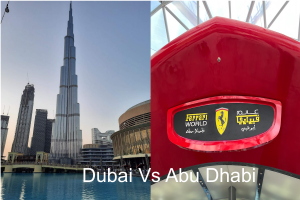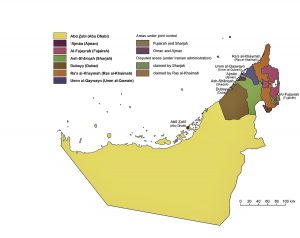
Qasr Al Hosn is the oldest building in Abu Dhabi, UAE. If you are planning to visit Qasr Al Hosn, here’s everything you need to know about Qasr Al Hosn.
Table of Contents
What is Qasr Al Hosn?
Qasr Al Hosn which means Palace (Qasr) Fort (Al Hosn) is the birthplace of Abu Dhabi. This historic center of Abu Dhabi is also known as White Fort or Old Fort.
In 1761 Qasr Al Hosn was constructed as Watch tower to protect only fresh water well on Abu Dhabi island. Qasr Al Hosn has been home to the ruling family since 1795 and acted as the seat of government till 1966 but today it stands as nation’s living memorial. This is the oldest building in Abu Dhabi and is now a popular museum since 2018.
It was designed by Mohammed Al Bastaki in 1761. Originally Its colour was not white but it was painted bright white during 1976–1983 renovations. The thick walls of Qasr Al Hosn are covered with plaster made of lime, sand and crushed sea shells.
When is Qasr Al Hosn open?
Qasr Al Hosn is open all days.
- Sunday 10 AM to 9 PM
- Monday 10 AM to 9 PM
- Tuesday 10 AM to 9 PM
- Wednesday 10 AM to 9 PM
- Thursday 10 AM to 9 PM
- Friday 2 PM to 10 PM
- Saturday 10 AM to 9 PM
Phone: +971 2 697 6400
During Ramadan timings differ as below
- Sunday 10 AM to 4 PM and 7 PM to 11 PM
- Monday 10 AM to 4 PM and 7 PM to 11 PM
- Tuesday 10 AM to 4 PM and 7 PM to 11 PM
- Wednesday 10 AM to 4 PM and 7 PM to 11 PM
- Thursday 10 AM to 4 PM and 7 PM to 11 PM
- Friday 7 PM to 2 AM
- Saturday 10 AM to 4 PM and 7 PM to 11 PM
How much does it cost? Can you book tickets in advance?
Tickets prices are as below
- Adult (18+) : AED 30
- Child (0-17) : Free
Tickets can be purchased at the entrance.
Alternately, tickets can also be booked in advance on Tiqets.
Tickets are issued for a day. You can visit during any time of the day during opening hours. Tickets include 15% discount on food and drinks at the restaurants.
How to reach Qasr Al Hosn?
By Taxi:
Qasr Al Hosn is located at the heart of the city. It is close to World Trade Center. It is easily accessible using Taxi. Although it is well known spot, our taxi driver was not aware of the location. So we used google maps to locate the same.
By Bus:
Bus number 32, 34, 40 routes go nearby Qasr Al Hosn center.
Location
Tip: Download Abu Dhabi Map in Google Map app. It will help you reach the destination in case you don’t have mobile data.
How long does it take to visit?
It takes at least 1 hour to visit the fort. However, if you read all the information given in each room, it might take up to 2 hours. Read sub-section below to know what to see and what not to miss in Qasr Al Hosn visit.
Qasr Al Hosn History
Since its inception in 1761, Qasr Al Hosn has seen all historic moments of Abu Dhabi, from when Abu Dhabi was a settlement relying on fishing and pearling till today to becoming richest and safest city in the world.
Before Construction
Construction and Afterwords
Qasr al Hosn was used for many purposes during its lifetime.
What to see in Qasr Al Hosn?
Qasr al Hosn has two parts: Inner Fort (built in 1795) and Outer Palace (built in 1939-45). Below is what you should see and not miss during your visit to Qasr Al Hosn.
Watch Tower

As per legend, one day, when Abu Dhabi was nothing but an open land, two Bani Yas tribe men were hunting gazelle. Tired and thirsty, they suddenly saw a gazelle drinking water. When they tested water, it was sweet. The legend of the gazelle leading the Bani Yas to water is often cited to explain why the island later became known as Abu Dhabi which literally means “father of the gazelle”.
Sheikh Dhiyab Bin Isa – Sheikh of the Bani Yas tribe from the inland Liwa Oasis – ordered for the watchtower to be constructed of coral and sea stone. After discovering water source on Abu Dhabi island, Bani Yas tribe established permanent settlement in early 1760s. They constructed the Watch Tower to protect only freshwater well on Abu Dhabi island. The water found on Abu Dhabi was not a single well, but shallow pools known as “scrapes”.
Inner Fort

Between 1793 to 1816, Sheikh Shakhbut Bin Dhiyab ordered the construction of more towers which can be seen today as Inner fort. The Bani Yas eventually moved seat of government from Al Dhafra to Abu Dhabi island. The inner fort was constructed to protect growing community and burgeoning pearling industry. A pavilion and prayer hall was also constructed as part of inner fort.
The fort was used as his seat of government, military headquarters, as well as his family home for the Ruling family. In other words it was Al Hosn (fort). Qasr Al Hosn was named “Hosn Abu Dhabi” which literally translates to Abu Dhabi Fort.
Inner fort displays gives information about history of the country and also shows artefacts and pictures of the history of the country of around 8000 years. The artefacts include ancient pottery artefacts, bangles, weapons, stone tools, oyster shells, leather well bucket. The history includes information of pearl industry to oil industry.
The inner fort is dedicated to the three most prominent leaders and the history of the Al Nahyan family or the Baniyas tribe, the leaders of Abu Dhabi.
Outer Palace

The construction of Qasr Al Hosn in 1939-45 converted the fort into palace as there were no more external threats for the people and the ruling family.
In outer palace you can see information regarding modern history since 1939 to 1966. This includes wireless radio communication sets and information about activities which men and women did in those days. Rooms of ruling families members are also shown. Things like radio, cameras which were used in those days are displayed.
The palace has traditional ‘Barjeel’ ventilation system – an ancient form of natural air conditioning.
North-East Tower

The North-East tower is one of Abu Dhabi’s iconic architectural symbols and features on 1000 dirham banknote. It was constructed during 1940s expansion and it is Qasr Al Hosn’s tallest and most ornate tower.
The tower includes several defensive elements like gun-slits and murder holes. The tower is three story building with cupola on the top.
Majlis

Majlis in Arabic means council. Paving design in this area marks out former site of majlis of Sheikh Shakhtub bin Sultan Al Nahyan. This was where Sheikh Shakhtub bin Sultan Al Nahyan held is public consultations and hosted visiting dignitaries.
Constructed in 1940s, initially it did not have roofs. In later years, alterations were done to the majlis building but in 1980s restoration it was taken down to bring it to earlier appearance.
Miniature Model

Above photo shows miniature model of Qasr Al Hosn. One can see Watch Tower, Inner Fort, North-East Tower, Outer Palace.
Architecture of Qasr Al Hosn
Qasr Al Hosn restoration took almost a decade which include traditional and modern architecture. It was made up of coral stone, sea stones, mangroves, areesh, and all kinds of traditional methods of construction materials, all of which provided a habitable enclosure in a harsh and arid desert landscape at the time.
- Material like wood from regional mangrove trees was used to build the palace. This wood is naturally resistant to termites, making it ideal for building structures.
- The floor is made of sarouj, which is a traditional way of baked clay compound.
- Qasr Al Hosn’s traditional barjeel ventilation system was used which is a ancient form of air conditioning and a traditional form of architecture common in the Gulf, Iran, and parts of Pakistan and Afghanistan.
Additional things to see near Qasr Al Hosn

House of Artisans
House of Artisans promotes the preservation of the UAE’s intangible heritage. Local artisans create beautiful artworks on-site, and these artworks are available to purchase.
House of Artisans protects and brings the traditional Emirati crafts of the past to the heart of contemporary culture, the centre offers training courses, educational workshops and other public events open to residents and travellers.
- Sadu is a traditional form of weaving practised by Arab women using sheep, camel and goat wool.
- Khoos is creating functional objects using date palm leaves.
- Talli, a traditional form of decorative embroidery practised by Emirati women on cotton or silk.
Cultural Foundation
Cultural Foundation, another great place to visit with children, is a world-renowned venue for culture and the arts. It was started in 1981.
It has workshops, classes, exhibitions for tourists while it has library for kids.
Where to eat near Qasr Al Hosn?

Qasr Al Hosn premises has few restaurants for quick snacks. With Qasr Al Hosn ticket, you get 15% discount at the below restaurants.
- The Espresso Lab
- Mirzam Chocolate Makers
- Wild & the Moon (Inside Cultural Foundation)
- Hazzaa Speciality Cafe
World Trade Center mall is within walking distance from Qasr Al Hosn. You can find many restaurants of different cuisines at WTC mall.
Qasr Al Hosn festival
Qasr al-Hosn festival is an annual 8 to 11 day cultural event staged on the grounds of the Qasr Al Hosn. The fort is open to the public during the festival, including some of the restricted areas. Festival features live music and dance performances showing the UAE’s cultural heritage.
Al Hosn Festival pass tickets are as below
- Adult (12+) : AED 100
- Child (0-11) : AED 50
The following is a list of activities that are held on a during the festival.
- Guards opening ceremony (9:00 am – 9:10 am)
- Guards March (4:00 pm – 4:10 pm)
- Guards Closing Ceremony (6:50 pm – 7:00 pm)
- Al Ayyala, which is a Performance of valor, music, poetry and more (10:00 am – 1:00 pm)
- Al-Taghrooda which is Poetry in the form of a song (10:00 am – 1:00 pm)
- Demonstrations of Marine Tradition (5:00 pm – 6:00 pm)
- AlRazfa which is a Dance of Unity (10:00 am – 1:00 pm)
- Falcon show which is UAE’s National Emblem (5:00 pm – 6:00 pm)
FAQs
- What is the meaning of Qasr Al Hosn?
Qasr Al Hosn means Palace (Qasr) Fort (Al Hosn). - When was Qasr Al Hosn built?
In 1761, Watch tower was first built to protect only freshwater well on Abu Dhabi island. This was the first permanent structure in Abu Dhabi. In 1795, the inner fort was constructed to protect growing community and burgeoning pearling industry. In the period 1939-45, outer palace was constructed. In 2018, it was renovated as museum. - How Abu Dhabi got its name?
As per legend, one day, when Abu Dhabi was nothing but an open land, two Bani Yas tribe men were hunting gazelle. Tired and thirsty, they suddenly saw a gazelle drinking water. When they tested water, it was sweet. The legend of the gazelle leading the Bani Yas to water is often cited to explain why the island later became known as Abu Dhabi which literally means “father of the gazelle”.




